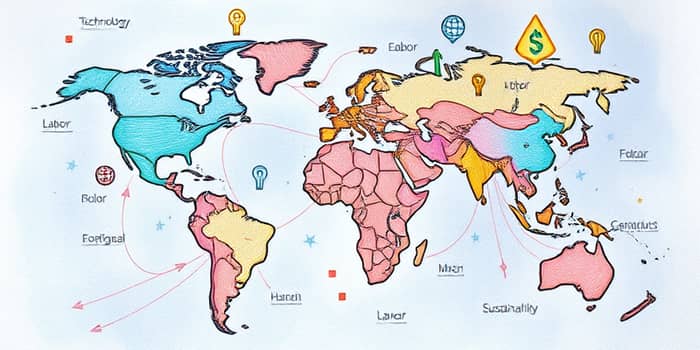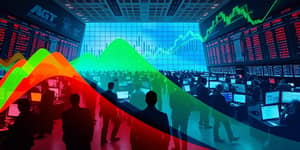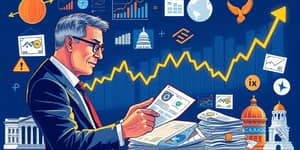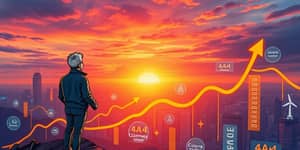As we navigate the evolving economic landscape of 2025, understanding the forces shaping global markets becomes essential for businesses, policymakers, and individuals seeking to thrive in uncertainty. This article explores the interconnected trends redefining growth, resilience, and purpose across continents.
A Multipolar Shift and Geopolitical Dynamics
The post–Cold War order has given way to an era of multiple centers of global power. While the United States remains influential, nations such as China and India are asserting themselves economically and diplomatically. This reshaping of alliances and blocs creates both opportunities for collaboration and new arenas of competition.
Non-state actors—including multinational corporations, NGOs, and networks—now wield unprecedented influence over trade, technology, and social norms. As Western dominance recedes, regional coalitions are experimenting with diverse approaches to fiscal regulation, environmental policy, and defense cooperation. These developments underscore a key truth: adaptability is critical in a world no longer governed by a single hegemon.
Trade Barriers and Supply Chain Strategies
Trade fragmentation is on the rise, driven by geopolitical tensions and national security concerns. Tariff spikes—such as a 50% levy on Brazilian goods and a 35% surcharge on Canadian exports to the United States—have prompted corporate leaders to rethink supply routes and sourcing policies.
In response, companies are increasingly embracing reshoring, nearshoring, and friendshoring initiatives. These strategies aim to mitigate risk, shorten delivery timelines, and foster resilience. Yet they also face hurdles: rising labor costs, uneven infrastructure, and diverse regulatory regimes among allied nations.
- Front-loading investments ahead of anticipated tariffs
- Diversifying supplier base across friendly markets
- Leveraging trade agreements to minimize barriers
By weighing cost efficiencies against geopolitical stability, organizations can chart supply chain designs that balance agility and reliability in an unpredictable environment.
Labor Market Realities and AI Impact
The global employment gap remains stark: some 402 million people are willing to work but face no opportunities, while 183 million are officially unemployed. Youth unemployment is particularly alarming, with 20.4% of 15–24-year-olds classified as NEET (Not in Employment, Education, or Training).
At the same time, automation and artificial intelligence are reshaping job landscapes. AI-driven processes enhance productivity but also risk displacing workers in manufacturing, logistics, and administrative roles. This duality reinforces long-standing inequalities between developed and emerging economies.
- Upskilling and lifelong learning programs
- Public-private partnerships for reemployment
- Inclusive AI governance frameworks
Fostering ethical adoption of emerging technologies will be pivotal to bridging workforce disparities and cultivating human potential in the Fourth Industrial Revolution.
Technology as a Catalyst for Change
With an estimated $10 billion uplift forecast for enterprise software through generative AI integration, companies are racing to harness advanced analytics and machine learning. Over half of marketing leaders are boosting budgets for AI-enabled personalization efforts, driving tailored consumer experiences and deeper brand loyalty.
Simultaneously, nations are investing in sovereign tech infrastructure—semiconductor fabrication, quantum computing labs, and secure data centers—to safeguard supply chains and intellectual property. This strategic competition underscores technology’s dual role as an economic accelerator and a geopolitical lever.
Responsible innovation and transparency are becoming watchwords. Organizations that prioritize ethical AI, data privacy, and societal impact stand to build stronger stakeholder trust and long-term resilience.
Sustainability and the Green Transition
Climate concerns and energy security have vaulted sustainability to the forefront of corporate and policy agendas. 2025 is widely viewed as a decisive year for scaling clean energy solutions—from solar and wind to green hydrogen and battery storage.
Companies face mounting pressure from investors, regulators, and consumers to demonstrate credible Environmental, Social, and Governance (ESG) commitments. Those that embed long-term climate strategies into their core operations not only mitigate risk but unlock new markets in carbon credits, green finance, and sustainable technologies.
- Accelerating investments in renewable energy projects
- Implementing circular economy practices
- Aligning corporate strategy with climate goals
Sectoral Winners and Vulnerabilities
This snapshot reveals how digitalization, policy shifts, and geopolitical frictions shape which industries flourish and which must adapt or contract.
Charting a Path Forward
Global market currents in 2025 are defined by fragmentation as much as by integration. While trade barriers and geopolitical realignments challenge traditional models, emerging technologies and sustainability imperatives offer fresh avenues for value creation.
To navigate these complexities, leaders must embrace three guiding principles:
- Agility in strategic planning—anticipate shifts and pivot swiftly.
- Inclusive innovation—ensure benefits of tech advancements reach all communities.
- Long-term sustainability focus—balance profit with planetary well-being.
By weaving these tenets into organizational cultures and national policies alike, we can harness interconnected trends for shared prosperity. The currents may be turbulent, but they also carry the promise of renewed growth, resilience, and global collaboration.
Conclusion
As global market currents ebb and flow, our collective response will shape the trajectory of economies and societies for decades to come. Armed with data, creativity, and a commitment to ethical progress, we can transform fragmentation into a mosaic of opportunities, driving inclusive growth in an increasingly interconnected world.
References
- https://www.oxfordeconomics.com/key-themes-2025/
- https://www.qualtrics.com/ebooks-guides/market-research-trends/
- https://www.cpifa.org/en/cms/book/419
- https://www.deloittedigital.com/nl/en/insights/perspective/marketing-trends-2025.html
- https://www.mckinsey.com/capabilities/strategy-and-corporate-finance/our-insights/global-economics-intelligence
- https://www.mckinsey.com/capabilities/mckinsey-digital/our-insights/the-top-trends-in-tech
- https://www.weforum.org/stories/2025/08/inflection-points-7-global-shifts-defining-2025-so-far-in-charts/










